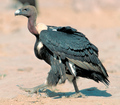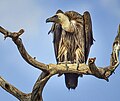Aegypiinae
Aegypiinae
Subfamily of birds
| Aegypiinae | |
|---|---|
| Lappet-faced vultures (left) and a white-backed vulture | |
| Scientific classification | |
| Domain: | Eukaryota |
| Kingdom: | Animalia |
| Phylum: | Chordata |
| Class: | Aves |
| Order: | Accipitriformes |
| Family: | Accipitridae |
| Subfamily: | Aegypiinae Sclater, WL, 1924[1] |
Aegypiinae is one of two subfamilies of Accipitridae that are referred to as Old World vultures, the other being the Gypaetinae. They are not closely related to the Gypaetinae, and are instead a sister group to the serpent-eagles (Circaetinae).[2][3]
Presently found throughout much of Africa, Asia, and parts of Europe, fossil evidence indicates that as recently as the Late Pleistocene, they ranged into Australia.[4][5]
The cladogram of the Aegypiinae shown below is based on a molecular phylogenetic study of the Accipitridae by Therese Catanach and collaborators that was published in 2024.[3]
| Aegypiinae |
| ||||||||||||||||||||||||||||||
Genera
| Genus | Common and binomial names | Image | Range |
|---|---|---|---|
| Necrosyrtes Gloger, 1841 | Hooded vulture Necrosyrtes monachus |
 |
Sub-Saharan Africa |
| Gyps Savigny, 1809 | Griffon vulture Gyps fulvus |
 |
Mountains in southern Europe, north Africa and Asia |
| White-rumped vulture Gyps bengalensis |
 |
Northern and central India, Pakistan, Nepal, Bangladesh and southeast Asia | |
| Rüppell's vulture Gyps rueppelli |
 |
The Sahel region of central Africa | |
| Indian vulture Gyps indicus |
 |
Central and peninsular India | |
| Slender-billed vulture Gyps tenuirostris |
 |
The Sub-Himalayan regions of India and into Southeast Asia | |
| Himalayan vulture Gyps himalayensis |
 |
The Himalayas and Tibetan Plateau | |
| White-backed vulture Gyps africanus |
 |
Savannahs of west and east Africa | |
| Cape vulture Gyps coprotheres |
 |
Southern Africa | |
| Sarcogyps Lesson, 1842 | Red-headed vulture Sarcogyps calvus |
 |
The Indian Subcontinent, with small disjunct populations in Southeast Asia |
| Trigonoceps Lesson, 1842 | White-headed vulture Trigonoceps occipitalis |
 |
Sub-Saharan Africa. Extinct populations have occurred in Indonesia.[6] |
| Torgos Kaup, 1828 | Lappet-faced vulture Torgos tracheliotos |
 |
Sub-Saharan Africa, the Sinai and Negev deserts and north-west Saudi Arabia |
| Aegypius Savigny, 1809 | Cinereous vulture Aegypius monachus |
 |
Southwestern and central Europe, Turkey, the central Middle East, northern India, central and east Asia |
| †Aegypius jinniushanensis | Pleistocene of China | ||
| †Aegypius prepyrenaicus | Pleistocene of Spain |
Fossil genera
| Subfamily | Genus | Common and binomial names | Image | Range |
|---|---|---|---|---|
| Aegypiinae | †Cryptogyps | †Cryptogyps lacertosus | Pleistocene of Australia | |
| †Gansugyps | †Gansugyps linxiaensis | Miocene of China |
† = extinct
- Bock, Walter J. (1994). History and Nomenclature of Avian Family-Group Names. Bulletin of the American Museum of Natural History. Vol. 222. New York: American Museum of Natural History. pp. 133, 257.
- Lerner, Heather R. L.; Mindell, David P. (2005). "Phylogeny of eagles, Old World vultures, and other Accipitridae based on nuclear and mitochondrial DNA". Molecular Phylogenetics and Evolution. 37 (2): 327–346. doi:10.1016/j.ympev.2005.04.010.
- Catanach, T.A.; Halley, M.R.; Pirro, S. (2024). "Enigmas no longer: using ultraconserved elements to place several unusual hawk taxa and address the non-monophyly of the genus Accipiter (Accipitriformes: Accipitridae)". Biological Journal of the Linnean Society: blae028. doi:10.1093/biolinnean/blae028.
- Mather, Ellen K.; Lee, Michael S. Y.; Worthy, Trevor H. (2022-07-20). "A new look at an old Australian raptor places "Taphaetus" lacertosus de Vis 1905 in the Old World vultures (Accipitridae: Aegypiinae)". Zootaxa. 5168 (1): 1–23. doi:10.11646/zootaxa.5168.1.1. ISSN 1175-5334. PMID 36101304. S2CID 250938004.
- "Mindat.org". www.mindat.org. Retrieved 2022-07-22.
- Hanneke J.M.; et al. "Continental-style avian extinctions on an oceanic island" (PDF). Repository.si.edu. Retrieved 17 October 2018.
- Ferguson-Lees, James; Christie, David A. (2001). Raptors of the World. Illustrated by Kim Franklin, David Mead, and Philip Burton. Houghton Mifflin. ISBN 978-0-618-12762-7. Retrieved 2011-05-26.
- Grimmett, Richard; Inskipp, Carol; Inskipp, Tim (1999). Birds of India, Pakistan, Nepal, Bangladesh, Bhutan, Sri Lanka, and the Maldives. Illustrated by Clive Byers et al. Princeton University Press. ISBN 978-0-691-04910-6. OCLC 43578307.
- Lerner, Heather R. L.; Mindell, David P. (November 2005). "Phylogeny of eagles, Old World vultures, and other Accipitridae based on nuclear and mitochondrial DNA" (PDF). Molecular Phylogenetics and Evolution. 37 (2): 327–346. doi:10.1016/j.ympev.2005.04.010. ISSN 1055-7903. PMID 15925523. Retrieved 31 May 2011.